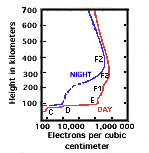#7. Plasma
Plasma is sometimes called "the fourth state of matter", beyond the familiar three--solid, liquid and gas. It is a gas in which atoms have been broken up into free-floating negative electrons and positive ions, atoms which have lost electrons and are left with a positive electric charge.
In the lower atmosphere where we live, any atom that loses an electron (say, by being hit by a fast cosmic ray particle) soon recaptures it or one like it. The situation is quite different at high temperatures, such as exist on the Sun. The hotter the gas, the faster its atoms and molecules move, and at very high temperatures, the collisions between such fast-moving atoms are violent enough to rip off electrons. In the Sun's atmosphere, a large fraction of the atoms at any time is "ionized" by such collisions, and the gas acts as a plasma.
Unlike cool gases, plasmas conduct electricity and are strongly affected by magnetic fields. The fluorescent lamp, widely used in the home and at work, contains plasma (main constituent, mercury vapor) which is heated and agitated by electricity, from the power line to which the lamp is connected. The power line makes one end electrically positive, the other negative (see drawing below) causing (+) ions to be accelerated towards the (-) end, and (-) electrons to the (+) end. The accelerated particles gain energy, collide with atoms, eject additional electrons and thus maintain the plasma; the collisions also cause atoms to emit light, and in fact, this source of light is more efficient than conventional lightbulbs. Neon signs and streetlights operate on a similar principle, and some plasma devices are (or were) used in electronics.
|

 A profile of the ionosphere.
A profile of the ionosphere.  Official GSFC Home Page
Official GSFC Home Page  NASA WWW Home Page
NASA WWW Home Page